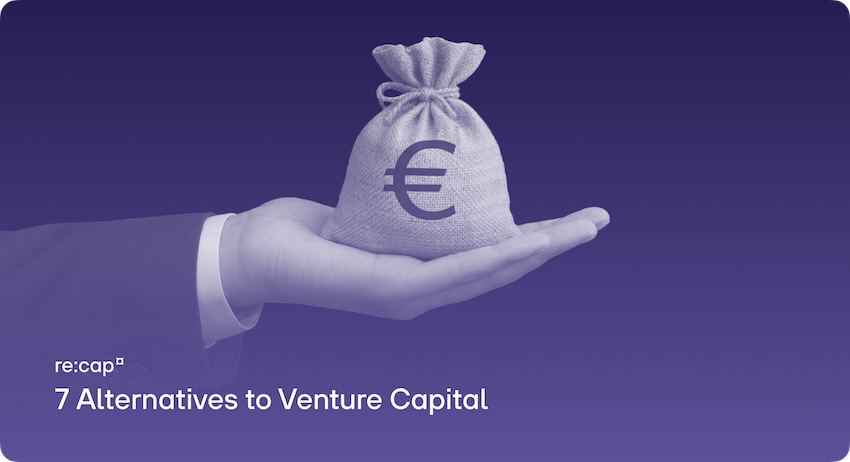Whether debt or equity: capital comes at a cost. Companies need to keep an eye on the cost of capital when funding their business and work capital efficiently. How can they achieve this?
What you'll learn in this article
- What cost of capital is
- How you can calculate cost of capital and evaluate it
- What implicit and explicit cost of capital are
- What impact cost of capital has on startups and their capital efficiency
TL;DR
- The cost of capital is the return a company must earn to make an investment worthwhile.
- Equity vs. Debt: equity funding has implicit cost of capital (like future dilution and profit sharing), while debt financing comes with explicit cost of capital (like interest payments). Both impact your company's long-term value differently.
- Overfunding hurts: raising more capital than needed leads to idle cash that still accrues costs. Efficient capital deployment is key to keeping costs low.
Definition: What is cost of capital?
Cost of capital is the cost when raising capital. They consist of equity and debt capital cost. To put it simply:
The cost of capital is the price you pay to use money.
But not all capital is the same:
- Debt capital has explicit capital cost: namely interest, which is contractually fixed in advance. Companies pay interest as regular (usually monthly) capital cost.
- Equity capital has implicit cost of capital. Investors expect a return on their investment. However, the return is not charged to the company until a later date, for example in the form of profit sharing.
For investors, the greater the risk of their capital transfer, the higher the expected return.
In the case of VC financing, a fixed return is rarely set in advance. Rather, it is measured by the number of shares the VC fund receives and later sells at a profit. Since this is in the future, it's hard to calculate a concrete cost of capital for equity financing.
The total cost of capital is the sum of the weighted cost of equity and debt. Equity and debt are weighted according to the company's share of a assets.
How to calculate cost of capital?
Companies can use various formulas to calculate the cost of capital. One cost of the capital formula is the WACC approach. WACC stands for "Weighted Average Cost of Capital". Usually, big corporations use it not startups.
The WACC formula
(Equity/Total Capital) * Interest on Equity + (Debt/Total Capital) * Interest on Debt * (1 - Income Tax Rate)
How to model the cost of capital?
While the overall Cost of Capital is measured by the WACC, a startup must calculate the Cost of Equity and the Cost of Debt separately.
1. Calculating the Cost of Debt
This is the most straightforward calculation, but it must be calculated after tax.
Cost of debt = Interest Rate x (1 – Tax Rate)
The term (1 – Tax Rate) represents the Tax Shield, demonstrating why debt is often cheaper than equity.
2. Calculating the Cost of Equity: The CAPM Approach
For mature companies, the Capital Asset Pricing Model (CAPM) is the standard:
Cost of Equity = Risk-Free Rate + Volatility relative to the market x (Expected Market Return – Risk-Free Rate)
Why WACC Doesn't Work for Startups
- No Stable Volatility relative to the market: Startups have no stock history, making Beta impossible to calculate.
- No Reliable Tax Rate: Pre-profit startups have no tax shield to measure.
- Unstable Capital Structure: The Debt/Equity ratio changes frequently with every small raise.
The Startup Proxy: Required IRR
Instead of WACC, startups should benchmark their required return against the Implicit Cost of Equity demanded by VCs. This is typically a high Internal Rate of Return (IRR) target:
Startup required return proxy = VC fund's required IRR (e.g., 40-80%)
Understanding cost of capital
Understanding the cost of capital is essential for making smart financial decisions: for running your business, investing in growth, or evaluating funding options.
Why?
Because your cost of capital defines the minimum return you need to generate to justify any investment, loan, or project.
Whether it comes from debt (like business loans) or equity (like investors). It tells you what it takes to finance your operations or future plans, and whether the expected return is worth it. If your return is lower than your cost of capital, you're destroying value. If it's higher, you're creating value.
You can use the cost of capital in many ways:
- assess the profitability of new investments
- decide whether to borrow or raise equity
- benchmark your performance
It also plays a key role in valuation. It affects how investors perceive your risk and future potential.
Interested in your funding scenario?
Get access to re:cap and calculate your funding terms or talk to one of our experts to find out how we can help you with our tailored debt funding.
Get your funding termsCost of debt
Cost of debt is the effective interest rate a company pays on its borrowed funds.
This includes loans, bonds, or credit lines. Because interest payments are tax-deductible, the cost of debt is usually calculated after tax. It’s generally lower than the cost of equity, since lenders take on less risk than investors – they get paid first and have collateral.
Cost of debt = what you pay to borrow money (usually lower, predictable, tax-deductible)
Cost of equity
Cost of equity, on the other hand, is the return that investors expect in exchange for owning a piece of the company.
It’s not a fixed payment like interest; it’s based on the perceived risk and potential return. Equity is more expensive because investors expect to be compensated for taking on higher risk, especially in startups or volatile markets.
Cost of equity = what you give up to raise money from investors (usually higher, risk-based, not tax-deductible)
Cost of capital for startups
For young companies, the true cost of capital is less about interest payments and more about strategic trade-offs that impact long-term value and control.
What role does the cost of capital play here, and how does it affect investment decisions?
1. The implicit cost of equity: Dilution & control
The cost is not paid today, but upon an Exit (IPO or M&A), and consists of two parts:
- Future Profit Sharing: Giving up a percentage of the net value of the company's future success.
- Cost of Control: Dilution reduces the founders' voting power. The implicit cost here is the loss of autonomy and the burden of reporting/governance demanded by VC investors.
This may cause implicit capital cost, which are unknown in advance.
The "true" costs of equity financing are different. Dilution reduces the influence of the founders on their own company. They hand over part of their ownership to external parties.
In addition, they profit less from the future increase in the company's value in the event of an exit or IPO.
In the case of equity, the cost of capital becomes real if parts of the company belong to the investors when it's sold and a portion of the profits goes to the investors.
2. Interest or warrants: debt capital is guaranteed to affect cost of capital
The situation is different in the case of financing with debt capital.
Banks are no longer the only providers of debt financing. Term and growth loans, recurring revenue financing/revenue-based financing, or venture debt: the list of alternative financing options beyond traditional lenders is long.
Debt funding involves explicit costs in the form of interest, with varying interest models and payment methods available, such as monthly, quarterly, annual, or even pay-in-kind loans.
Here, the explicit cost of capital can be precisely quantified and are known in advance. As a result, they can be structured more efficiently.
In some situations, opting for debt financing with direct interest burdens instead of equity might be more advantageous. Such a decision can potentially enhance the company's long-term value.
Short- and long-term impacts
As mentioned at the beginning, startups can access various forms of debt financing. With a term loan, for example, they receive a large sum in a single swoop. What is positive in the short-term can become a challenge in the long-term.
Why? It drives cost of capital.
On the one hand, the company has a huge plus in its account. On the other hand, interest accrues directly on the debt capital. Usually, a startup can not invest the whole funding amount. It takes several months, sometimes even a year, until the capital is put to work.
A large part of the money remains in the bank. There it causes unnecessary capital cost.

Overfunding drives the cost of capital
In this scenario, overfunding arises when a startup retains capital without utilizing or investing it. This is the key actionable takeaway: Overfunding severely degrades capital efficiency.
While gathering a bit more cash than necessary can be prudent to avoid liquidity bottlenecks, it impacts capital efficiency.
It's simple: if a company raises €1M but is only able to deploy €500K its working not very cost efficient. The remaining €500K stay in their bank account and cause capital cost.
That's why efficiently deploying available capital for results becomes crucial, as inefficiencies arise when money remains unused while incurring costs.
Term loans, a popular choice among startups, contribute to this effect. They typically feature
- fixed interest rate at the beginning of the term,
- regular interest payment that remains the same throughout the term of the loan, and
- longer repayment period of between one and ten years.
Though such loans provide immediate access to the whole financing volume, the direct interest payment can pose challenges. Careful management becomes essential to maintain capital efficiency and avoid potential issues.
Does the money sit in the bank, or is it deployed?
Indeed, when financing, capital needs may significantly differ from the actual payout amount. And these needs can fluctuate monthly or quarterly.
Opting for a long-term loan offers security and stability, but this also affects a company's cost of capital and capital efficiency over the long haul. Two reasons account for this:
- Even if the business doesn't develop as expected, the startup must still pay interest and may need to adjust its business plan accordingly.
- While having ample capital is advantageous, it must be deployed efficiently within a specific timeframe (capital deployment). However, some investments may not be viable or useful for several months.
Unused capital leads to unnecessary costs, and this money remains idle in the bank account. Startups should carefully consider whether securing a large debt financing all at once is the best approach.
3 proven strategies to reduce cost of capital
Founders have direct control over strategic decisions that lower their effective CoC.
- Eliminate Overfunding with Flexible Debt:
- Avoid lump-sum Term Loans (which cause the high CoC of idle cash).
- Utilize solutions like Revenue-Based Financing (RBF) or Flexible Credit Lines. These allow you to draw capital only when it is needed to cover expenses, ensuring that you only pay interest on the capital that is actively generating returns. This maximizes capital deployment efficiency.
- Negotiate Warrants and Covenants (Debt):
- Warrants: Negotiate to minimize the percentage of equity granted or link warrant vesting to specific, achievable business milestones.
- Covenants: Challenge overly restrictive covenants (like minimum cash reserves), as these restrict your ability to invest capital efficiently.
- Optimize the Capital Mix (WACC):
- Since Debt is generally cheaper than Equity (due to the tax shield and lower risk for the lender), a stable, growth-stage company can lower its overall WACC by strategically replacing a portion of equity with non-dilutive debt. This balances the low explicit cost of debt against the high implicit cost of equity.
Fortunately, overfunding's adverse impacts on the cost of capital and capital efficiency can be mitigated through alternative financing models. Tailored debt funding solutions, like re:cap, present viable options that reduce capital cost significantly.
By choosing re:cap, businesses can expect approximately 40 to 60% lower capital cost compared to debt alternatives such as term loans.
Achieving this benefit involves conducting an individual needs analysis of revenue development and the business plan. With a clear understanding of a company's monthly capital requirement, they can customize their financing accordingly, ensuring optimal financial efficiency and strategic growth.

Financing adapted to business – not the other way around
Young companies, in particular, find great benefits in adapting their financing to match their business development. Within their financing framework, they access external capital only when necessary, minimizing their cost of capital.
Therefore, the key are tailored solutions to create customized funding and repayment plans based on the company's capital needs.
Funding based on cash flow needs
This approach allows for precise monthly and daily determination of requirements, ensuring efficient cost of capital. Timing and amounts align with the business plan and current developments. The financing volume is adjusted accordingly, increasing or decreasing as needed.
For startups, these advantages are significant:
- They avoid overfunding, securing funds according to their actual capital needs.
- The cost of capital remains lower due to precise financing arrangements.
- They operate in a capital-efficient manner.
- The revolving financing volume adapts to their needs, providing flexibility to increase or decrease financing based on the situation.
This approach empowers startups to make optimal financial decisions and maintain a stable financial position, fostering sustainable growth and success.
Keep an eye on your cost of capital
For startups, the cost of capital holds significant importance in investment decisions. To make informed choices, young companies must evaluate critical questions: When is capital needed? How much is required? What funding amount suits their needs?
By answering these questions, startups can identify the financing model that aligns with their use case. Crucially, the capital cost should not have a lasting, adverse effect on a company's ability to meet financial obligations and it should not dangerously shorten their cash runway.
If this occurs, the investment might yield outcomes opposite to what the founders envisioned. Prioritizing well-considered financial planning and selecting the right financing options can pave the way for long-term success and growth.
Summary: Cost of capital
The cost of capital is the price a company pays to access money, either through debt (like loans) or equity (like investor funding).
Debt has explicit, predictable costs in the form of interest, while equity involves implicit costs, such as giving up shares and future profits.
Startups often rely on both forms of capital, but each choice impacts financial flexibility, control, and long-term company value. The total cost of capital is calculated using methods like WACC, balancing debt and equity based on their proportion in the business.
Q&A: Cost of capital
Why is cost of capital important?
Because it defines the minimum return a company needs to justify an investment. If your return is lower than your cost of capital, you’re destroying value. If it's higher, you're creating value. It’s a key metric for financing, valuation, and strategic planning.
What is an example of a capital cost?
Interest payments on a loan are a classic example of a capital cost. It’s a direct, contractual cost a company pays to access borrowed money.
What is the difference between cost of capital and WACC?
Cost of capital is the general term for the price of using debt or equity funding. WACC (Weighted Average Cost of Capital) is a specific formula used to calculate a company’s overall cost of capital by weighting the cost of equity and debt based on their proportion in the capital structure.
Is cost of capital the same as discount rate?
Often, yes. In company valuation, the cost of capital is typically used as the discount rate to calculate the present value of future cash flows. However, the discount rate can vary depending on the context and assumptions used.
Interested in your funding scenario?
Get access to re:cap and calculate your funding terms or talk to one of our experts to find out how we can help you with our tailored debt funding.
Get your funding terms

.gif)








